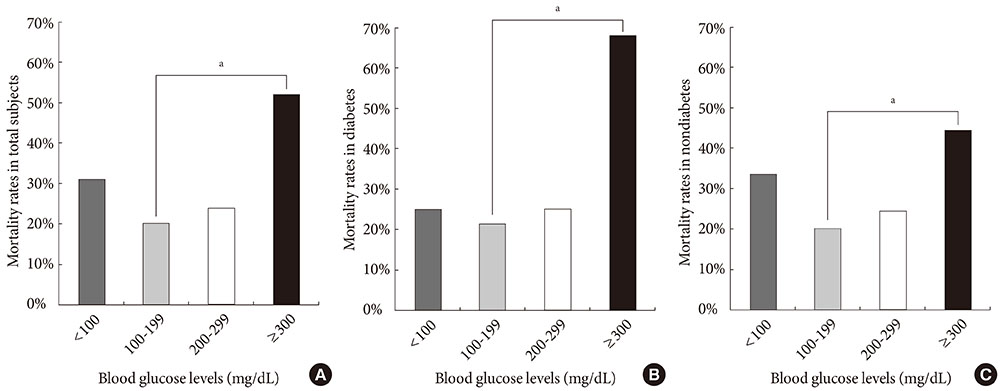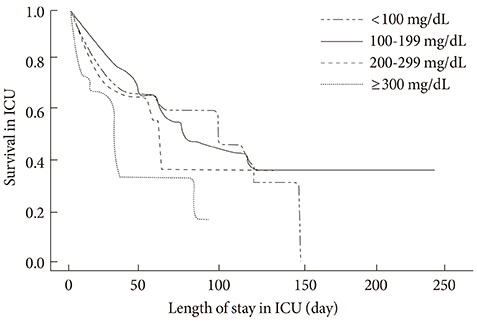Diabetes Metab J.
2013 Oct;37(5):385-390. 10.4093/dmj.2013.37.5.385.
Predicting Mortality of Critically Ill Patients by Blood Glucose Levels
- Affiliations
-
- 1Department of Internal Medicine, Yeungnam University College of Medicine, Daegu, Korea. jsyoon9@ynu.ac.kr
- KMID: 1965986
- DOI: http://doi.org/10.4093/dmj.2013.37.5.385
Abstract
- BACKGROUND
The aim of this study is to observe the outcome of critically ill patients in relation to blood glucose level at admission and to determine the optimal range of blood glucose at admission predicting lower hospital mortality among critically ill patients.
METHODS
We conducted a retrospective cohort study of a total 1,224 subjects (males, 798; females, 426) admitted to intensive care unit (ICU) from 1 January 2009 to 31 December 2010. Blood glucose levels at admission were categorized into four groups (group 1, <100 mg/dL; group 2, 100 to 199 mg/dL; group 3, 200 to 299 mg/dL; and group 4, > or =300 mg/dL).
RESULTS
Among 1,224 patients, 319 patients were already known diabetics, and 296 patients died in ICU. Five hundred fifty-seven subjects received insulin therapy, and 118 received oral hypoglycemic agents. The overall mortality rate was 24.2% (296 patients). The causes of death and mortality rates of diabetic patients were not different from nondiabetic subjects. The mortality curve showed J shape, and there were significant differences in mortality between the groups of blood glucose levels at admission. Group 2 had the lowest mortality rate (P<0.05).
CONCLUSION
These results suggest that serum glucose levels upon admission into ICU is associated with clinical outcomes in ICU patients. Blood glucose level between 100 and 199 mg/dL at the time of ICU admission could predict lower hospital mortality among critically ill patients.
Keyword
MeSH Terms
Figure
Reference
-
1. Levetan CS, Passaro M, Jablonski K, Kass M, Ratner RE. Unrecognized diabetes among hospitalized patients. Diabetes Care. 1998; 21:246–249.2. Umpierrez GE, Isaacs SD, Bazargan N, You X, Thaler LM, Kitabchi AE. Hyperglycemia: an independent marker of in-hospital mortality in patients with undiagnosed diabetes. J Clin Endocrinol Metab. 2002; 87:978–982.3. Clement S, Braithwaite SS, Magee MF, Ahmann A, Smith EP, Schafer RG, Hirsch IB. American Diabetes Association Diabetes in Hospitals Writing Committee. Management of diabetes and hyperglycemia in hospitals. Diabetes Care. 2004; 27:553–591.4. Kavanagh BP, McCowen KC. Clinical practice: glycemic control in the ICU. N Engl J Med. 2010; 363:2540–2546.5. Mizock BA. Alterations in carbohydrate metabolism during stress: a review of the literature. Am J Med. 1995; 98:75–84.6. Kansagara D, Wolf F, Freeman M, Helfand M. Management of inpatient hyperglycemia: a systematic review. Washington, DC: Department of Veterans Affairs, Veterans Health Administration, Health Services Research & Development Service;2008.7. ACE/ADA Task Force on Inpatient Diabetes. American College of Endocrinology and American Diabetes Association Consensus statement on inpatient diabetes and glycemic control. Diabetes Care. 2006; 29:1955–1962.8. Malmberg K, Ryden L, Wedel H, Birkeland K, Bootsma A, Dickstein K, Efendic S, Fisher M, Hamsten A, Herlitz J, Hildebrandt P, MacLeod K, Laakso M, Torp-Pedersen C, Waldenstrom A. DIGAMI 2 Investigators. Intense metabolic control by means of insulin in patients with diabetes mellitus and acute myocardial infarction (DIGAMI 2): effects on mortality and morbidity. Eur Heart J. 2005; 26:650–661.9. Malmberg K, Ryden L, Efendic S, Herlitz J, Nicol P, Waldenstrom A, Wedel H, Welin L. Randomized trial of insulin-glucose infusion followed by subcutaneous insulin treatment in diabetic patients with acute myocardial infarction (DIGAMI study): effects on mortality at 1 year. J Am Coll Cardiol. 1995; 26:57–65.10. ADVANCE Collaborative Group. Patel A, MacMahon S, Chalmers J, Neal B, Billot L, Woodward M, Marre M, Cooper M, Glasziou P, Grobbee D, Hamet P, Harrap S, Heller S, Liu L, Mancia G, Mogensen CE, Pan C, Poulter N, Rodgers A, Williams B, Bompoint S, de Galan BE, Joshi R, Travert F. Intensive blood glucose control and vascular outcomes in patients with type 2 diabetes. N Engl J Med. 2008; 358:2560–2572.11. Duckworth W, Abraira C, Moritz T, Reda D, Emanuele N, Reaven PD, Zieve FJ, Marks J, Davis SN, Hayward R, Warren SR, Goldman S, McCarren M, Vitek ME, Henderson WG, Huang GD. VADT Investigators. Glucose control and vascular complications in veterans with type 2 diabetes. N Engl J Med. 2009; 360:129–139.12. Action to Control Cardiovascular Risk in Diabetes Study Group. Gerstein HC, Miller ME, Byington RP, Goff DC Jr, Bigger JT, Buse JB, Cushman WC, Genuth S, Ismail-Beigi F, Grimm RH Jr, Probstfield JL, Simons-Morton DG, Friedewald WT. Effects of intensive glucose lowering in type 2 diabetes. N Engl J Med. 2008; 358:2545–2559.13. Brunkhorst FM, Engel C, Bloos F, Meier-Hellmann A, Ragaller M, Weiler N, Moerer O, Gruendling M, Oppert M, Grond S, Olthoff D, Jaschinski U, John S, Rossaint R, Welte T, Schaefer M, Kern P, Kuhnt E, Kiehntopf M, Hartog C, Natanson C, Loeffler M, Reinhart K. German Competence Network Sepsis (SepNet). Intensive insulin therapy and pentastarch resuscitation in severe sepsis. N Engl J Med. 2008; 358:125–139.14. van den Berghe G, Wouters P, Weekers F, Verwaest C, Bruyninckx F, Schetz M, Vlasselaers D, Ferdinande P, Lauwers P, Bouillon R. Intensive insulin therapy in critically ill patients. N Engl J Med. 2001; 345:1359–1367.15. Van den Berghe G, Wilmer A, Hermans G, Meersseman W, Wouters PJ, Milants I, Van Wijngaerden E, Bobbaers H, Bouillon R. Intensive insulin therapy in the medical ICU. N Engl J Med. 2006; 354:449–461.16. NICE-SUGAR Study Investigators. Finfer S, Chittock DR, Su SY, Blair D, Foster D, Dhingra V, Bellomo R, Cook D, Dodek P, Henderson WR, Hébert PC, Heritier S, Heyland DK, McArthur C, McDonald E, Mitchell I, Myburgh JA, Norton R, Potter J, Robinson BG, Ronco JJ. Intensive versus conventional glucose control in critically ill patients. N Engl J Med. 2009; 360:1283–1297.17. Wiener RS, Wiener DC, Larson RJ. Benefits and risks of tight glucose control in critically ill adults: a meta-analysis. JAMA. 2008; 300:933–944.18. Langley J, Adams G. Insulin-based regimens decrease mortality rates in critically ill patients: a systematic review. Diabetes Metab Res Rev. 2007; 23:184–192.19. Kreutziger J, Wenzel V, Kurz A, Constantinescu MA. Admission blood glucose is an independent predictive factor for hospital mortality in polytraumatised patients. Intensive Care Med. 2009; 35:1234–1239.20. Appelboom G, Piazza MA, Hwang BY, Carpenter A, Bruce SS, Mayer S, Connolly ES Jr. Severity of intraventricular extension correlates with level of admission glucose after intracerebral hemorrhage. Stroke. 2011; 42:1883–1888.21. McCowen KC, Malhotra A, Bistrian BR. Stress-induced hyperglycemia. Crit Care Clin. 2001; 17:107–124.22. American Diabetes Association. Standards of medical care in diabetes: 2013. Diabetes Care. 2013; 36:Suppl 1. S11–S66.23. Wass CT, Lanier WL. Glucose modulation of ischemic brain injury: review and clinical recommendations. Mayo Clin Proc. 1996; 71:801–812.24. Moghissi ES, Korytkowski MT, DiNardo M, Einhorn D, Hellman R, Hirsch IB, Inzucchi SE, Ismail-Beigi F, Kirkman MS, Umpierrez GE. American Association of Clinical Endocrinologists; American Diabetes Association. American Association of Clinical Endocrinologists and American Diabetes Association consensus statement on inpatient glycemic control. Endocr Pract. 2009; 15:353–369.25. American Diabetes Association. Standards of medical care in diabetes: 2012. Diabetes Care. 2012; 35:Suppl 1. S11–S63.26. Lepper PM, Ott S, Nuesch E, von Eynatten M, Schumann C, Pletz MW, Mealing NM, Welte T, Bauer TT, Suttorp N, Juni P, Bals R, Rohde G. German Community Acquired Pneumonia Competence Network. Serum glucose levels for predicting death in patients admitted to hospital for community acquired pneumonia: prospective cohort study. BMJ. 2012; 344:e3397.27. Klein GW, Hojsak JM, Schmeidler J, Rapaport R. Hyperglycemia and outcome in the pediatric intensive care unit. J Pediatr. 2008; 153:379–384.28. Naber CK, Mehta RH, Junger C, Zeymer U, Wienbergen H, Sabin GV, Erbel R, Senges J, Gitt A. Impact of admission blood glucose on outcomes of nondiabetic patients with acute ST-elevation myocardial infarction (from the German Acute Coronary Syndromes [ACOS] Registry). Am J Cardiol. 2009; 103:583–587.29. Bejot Y, Aboa-Eboule C, Hervieu M, Jacquin A, Osseby GV, Rouaud O, Giroud M. The deleterious effect of admission hyperglycemia on survival and functional outcome in patients with intracerebral hemorrhage. Stroke. 2012; 43:243–245.30. Bagshaw SM, Bellomo R, Jacka MJ, Egi M, Hart GK, George C. ANZICS CORE Management Committee. The impact of early hypoglycemia and blood glucose variability on outcome in critical illness. Crit Care. 2009; 13:R91.
- Full Text Links
- Actions
-
Cited
- CITED
-
- Close
- Share
- Similar articles
-
- Response: Predicting Mortality of Critically Ill Patients by Blood Glucose Levels (Diabetes Metab J 2013;37:385-90)
- Letter: Predicting Mortality of Critically Ill Patients by Blood Glucose Levels (Diabetes Metab J 2013;37:385-90)
- Glycemic Targets for the Critically Ill Patient
- Glycemic control in acute illness
- The Effect of Hyperglycemia on the Prognosis of Critically Ill Patients Does Not Differ Diabetics from Nondiabetics



